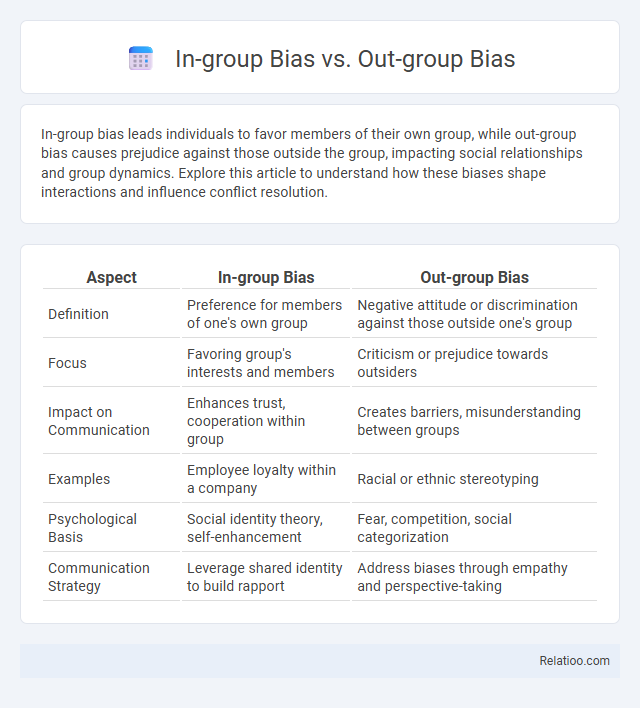In-group bias leads individuals to favor members of their own group, while out-group bias causes prejudice against those outside the group, impacting social relationships and group dynamics. Explore this article to understand how these biases shape interactions and influence conflict resolution.
Table of Comparison
| Aspect | In-group Bias | Out-group Bias |
|---|---|---|
| Definition | Preference for members of one's own group | Negative attitude or discrimination against those outside one's group |
| Focus | Favoring group's interests and members | Criticism or prejudice towards outsiders |
| Impact on Communication | Enhances trust, cooperation within group | Creates barriers, misunderstanding between groups |
| Examples | Employee loyalty within a company | Racial or ethnic stereotyping |
| Psychological Basis | Social identity theory, self-enhancement | Fear, competition, social categorization |
| Communication Strategy | Leverage shared identity to build rapport | Address biases through empathy and perspective-taking |
Understanding In-group Bias: Definition and Characteristics
In-group bias refers to the tendency for individuals to favor members of their own group over those in out-groups, often leading to preferential treatment and positive evaluations of in-group members. This bias is characterized by enhanced trust, cooperation, and solidarity within the group, while potentially fostering stereotypes and discrimination against out-group members. Understanding in-group bias helps you recognize how social identity influences perception and behavior, impacting interpersonal and intergroup relations.
Out-group Bias Explained: Key Features and Examples
Out-group bias refers to the tendency to negatively evaluate or discriminate against individuals who belong to a different group than your own, often leading to unfair treatment and stereotyping. Key features include favoritism towards the in-group, perceived threat from the out-group, and reduced empathy or trust towards outsiders. Examples of out-group bias are evident in workplace discrimination, social segregation, and polarized political environments.
Psychological Mechanisms Behind Group Biases
In-group bias and out-group bias reflect psychological mechanisms that prioritize favoring your own group while devaluing others, rooted in social identity theory and cognitive categorization processes. These biases stem from evolutionary survival strategies that enhance group cohesion and cooperation but can lead to stereotyping, prejudice, and discrimination against out-group members. Understanding these mechanisms helps to identify how implicit attitudes and social norms influence your perceptions and behaviors toward different social groups.
Evolutionary Roots of In-group and Out-group Preferences
In-group bias and out-group bias stem from evolutionary mechanisms that enhanced survival by fostering strong group cohesion and vigilance against outsiders. Humans developed preferences for in-group members to ensure cooperation, resource sharing, and protection within familiar social groups, while out-group biases served to guard against potential threats and competition from unfamiliar individuals. These cognitive biases manifest as favoring those perceived as similar and distrusting unfamiliar groups, reflecting deep-rooted evolutionary strategies for social organization and survival.
Social Identity Theory and Its Role in Group Bias
Social Identity Theory explains how Your sense of belonging to a particular group fosters in-group bias, which favors members of Your own group, while out-group bias leads to prejudice against those perceived as outsiders. These biases arise from the desire to enhance self-esteem and group status, influencing social perception and behavior significantly. Understanding these dynamics helps identify the roots of intergroup conflict and promotes strategies to reduce group-based discrimination.
Real-world Consequences of In-group and Out-group Bias
In-group bias leads to favoritism toward members within one's own social group, fostering cooperation and trust but often resulting in exclusion and discrimination against out-group members. Out-group bias amplifies negative stereotypes and hostility, contributing to social divisions, prejudice, and conflicts in communities, workplaces, and institutions. Both biases affect decision-making processes, resource allocation, and social cohesion, perpetuating systemic inequalities and impeding efforts toward diversity and inclusion.
In-group Favoritism vs. Out-group Discrimination
In-group favoritism refers to the tendency for people to prioritize and positively evaluate members of their own group, enhancing trust and cooperation within that group. Out-group discrimination involves negative judgments and behaviors directed against those perceived as outsiders, often leading to exclusion or prejudice. Understanding these biases helps You recognize how group dynamics influence social interactions and decision-making processes.
Strategies to Reduce Group Bias in Society
Reducing group bias in society requires targeted strategies such as promoting intergroup contact to foster empathy and understanding between in-groups and out-groups, which diminishes prejudice. Implementing diversity education and inclusive policies can challenge stereotypical thinking and reduce generalized bias by increasing awareness of unconscious favoritism. Your active engagement in dialogue and collaboration across diverse social groups helps break down barriers and creates more equitable communities.
Impact of Group Biases on Decision-Making
In-group bias leads individuals to favor members of their own group, often resulting in preferential treatment and skewed judgments that enhance group cohesion but undermine fairness. Out-group bias triggers negative stereotypes and discrimination against those perceived as outsiders, impairing objective decision-making and fostering social division. Both biases distort rational evaluation, causing decision-makers to overlook essential facts and perpetuate inequality in organizational, social, and political contexts.
Future Research Directions for Group Bias Studies
Future research on group bias should prioritize exploring the neurocognitive mechanisms differentiating in-group bias and out-group bias, using advanced neuroimaging techniques to uncover underlying neural correlates. Investigations into the role of intersectionality and contextual factors can provide a nuanced understanding of how multiple social identities influence bias formation and expression. Developing and testing intervention strategies that leverage virtual reality and artificial intelligence may offer scalable solutions to mitigate both in-group favoritism and out-group discrimination in diverse social settings.

Infographic: In-group Bias vs Out-group Bias
 relatioo.com
relatioo.com